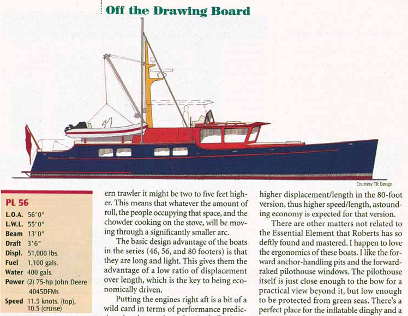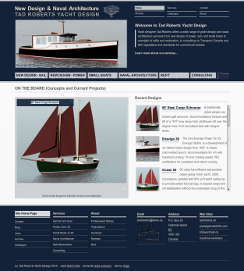Passagemaker Lite 46
Similar Designs
Sail-Assisted Powerboats
Traditional Motorsailer
PL 46 Stock Plans
Construction Method and Materials:
Hull Form and Construction. Round bottom sheathed strip or cold-molded (3 layers) wood construction. Foam cored fiberglass construction option. Multi-chine aluminum plate construction.Number and Type of Drawings:
Full size plot files for hull station molds, bulkheads, deck and house beams, stem, etc.CAD Drawings:
CAD drawings of general construction, construction sections, tanks, deckhouse, profile and arrangement, shaft and rudder plan.Base Price:
- Full Plans in either wood or aluminum construction $3900 CAD
- Full Size Lofting Plots for wood or fiberglass available $1750 CAD
- Full Size Metal Parts Plots $3200 CAD
Design Review
- Off the Drawing Board: Passagemaker Lite 46, 56, and 80 PDF
- Art Paine, Maine Boats and Harbors, Issue 76, Autumn 2003
There is nothing new to the idea of thin, light, seaworthy, and fast powerboats, and Tad Roberts has been inspired by several of those of the past. To Roberts, these boats brought to mind a glaring question: Why didn't the whole world flock to these sensible and efficient pleasure powerboat designs? He answered that question by identifying the elements that limited the type, and, in his Lite designs, addressed them. All in all, the Passagemaker Lite series is masterful work.

Read articles by Tad Roberts about Passagemaker Lite:
-
“Passagemaker Lite” (Professional Boatbuilder) PDF
“Passagemaker Lite: A Modern Lightweight Restatement of the Lean Long-range Power Cruiser ”
Professional BoatbuilderNumber 81, Feb/March 2003 -
“Passagemaker Lite” (Passagemaker) PDF
“Passagemaker Lite: A Modern Lightweight Restatement of the Lean Long-range Power Cruiser”
Passagemaker Magazine 2003 -
“ A Brief History of Lightweight Motor Yachts ” (Passagemaker) PDF,
“A Brief History of Lightweight Motor Yachts ” Passagemaker Magazine2003
Read more on Tad Roberts Yacht Design main web site:
Designer's Comments
Some Defining Characteristics of the Passagemaker Lite design. From “Passagemaker Lite” (Professional Boatbuilder) PDF
Passagemaker Lite, the design series presented here, is a high-speed displacement hullform, a shape closer to a naval frigate than a fishing vessel. It has a long waterline, relatively narrow beam, and fine entry. In the manner of a frigate, there is some rise to the sections aft, but there is still deep immersion of the hull at the transom.
Waterline Length
I created Passagemaker Lite with maximum waterline length for a number of reasons. For a given displacement, the long waterline reduces wave-making, the major resistance component at the higher speed/length ratios where Passagemaker Lite will cruise. A longer waterline also means that the hull's entrance can be finer again, reducing resistance. Finally, the long waterline provides more usable interior space than a hull of similar length with substantial overhangs. This brings us to freeboard. Passagemaker Lite's hull has moderate freeboard forward. Why? Higher freeboard means increased weight and windage. Because of the short overhang, Passagemaker Lite's bow starts to lift as soon as it encounters a wave, thus the boat can stay dry, even with lower freeboard. The bow is similar to that of modern high-performance sailboats. An important factor is keeping weights as far aft as possible, and a bulbous bow provides reserve buoyancy. Finally, I have included a full-length spray rail above the waterline to allow for increased buoyancy up high, keeping the deck drier at speed, like the configuration favored on Jim Hawkins, a light-displacement ocean cruiser constructed by Bob Derecktor and designed by Avard Fuller.
Beam/Length Ratio
The best way to recognize Passagemaker Lite is beam/length ratio. With a beam of 15.42 ft. (4.7m) and overall length of 45.75 ft. (13.9m), the Nordhavn 46 has a beam/length ratio of 0.34. That of the Krogen 42 is 0.35. This is typical of most modern trawler yachts. In contrast, the beam/length ratio for the L. Francis Herreshoff-designed offshore cruiser Marco Polo is 0.18 and that of Jim Hawkins is 0.21. These are a bit extreme for my taste. My designs have more beam and thus more interior space. For example, beam/length for the Passagemaker Lite (or PL) 56 is 0.24; the PL 46 is 0.26, and the PL 80 is 0.22. I think we can safely say that typical modern trawlers have a beam/length ratio of over .32, while Passagemaker Lite will be between 0.20 and 0.26.
Stability
A concern with both heavy- and light-displacement passagemakers is stability. A vessel's displacement is equal to the total weight of its structure, ballast, and payload. The structural weight, on the other hand, is dependent on its size: the smaller the boat, the lighter the weight. Less ballast is made more effective by using lightweight cored structures in decks and cabintops, and by minimizing the height of those structures above the waterline to reduce the boat's roll-inertia (the tendency for a mass to keep moving once in motion). Also, the lower and more centered the weights are, the less energy is required to damp out rolling once it starts.
Resistance and Speed Predictions
For the Passagemaker Lite 56, I chose a pair of John Deere 4045DFM 4-cyl naturally aspirated engines. These engines produce a maximum of 75 BHP@2,400 rpm, and have ZF 63 IV V-drive reduction gears mounted directly on them. A reduction of 2.477:1 is a maximum of 970 rpm at the propellers. Exact resistance figures for the PL 56 await tank-testing, but I can make some predictions based on the work of Roger Compton, the current dean of Webb Institute. His 1986 paper "Resistance of a Series of Semi-Planing Transom Stern Hulls", published by the Society of Naval Architects and Marine Engineers, is a useful guide to predicting the resistance of this hull type.
Internal Volume
Internal volume is another question. Cubic numbers can be useful in comparing vessels of differing dimensions. This is simply length x beam x depth. Length is LOA + LWL divided by two. Depth is height from main deck to fairbody. The Nordhavn 46 has a cubic number of 42.04 x 15.5 x 8 = 5,200. That of Jim Hawkins is 59.66 x 13 x 7.5 = 5,800 (about 11% more). The Nordhavn has more interior above the main deck level and therefore achieves similar volume. This comes at the cost of a higher center of gravity. The cubic number of the PL 56 is about 4,900 (94% of the Nordhavn's). It will have somewhat less space because the only double-decking will be where the flybridge/boat deck extends over the main cabin. I minimize the narrow feeling in Passagemaker Lite designs by utilizing the full hull width as much as possible with a raised topsides and flush deck. Raised topsides also add to the boat's ultimate stability range, creating a safer vessel than the usual trawler with its low side decks. My designs achieve their light weight by being narrower and lower in profile. Thus, they are of smaller section than wider higher vessels. Because of their length, they still provide reasonable interior space. And, less tankage means more interior space for accommodations.
Weight
Can Passagemaker Lite be built to this seemingly optimistic weight target? I believe so, but it will take a slight shift in mindset to achieve it. In the current crop of wide, heavy trawler yachts, heavy is good. This is true if you're trying to weigh down a huge hull designed to carry a load of fish, or if you're trying to slow the motion of a high and wide hull. Passagemaker Lite is the opposite. I want to make it stronger and lighter. This is the same principle driving the creation of both modern trawler cats and ultralight sailing cruisers.


